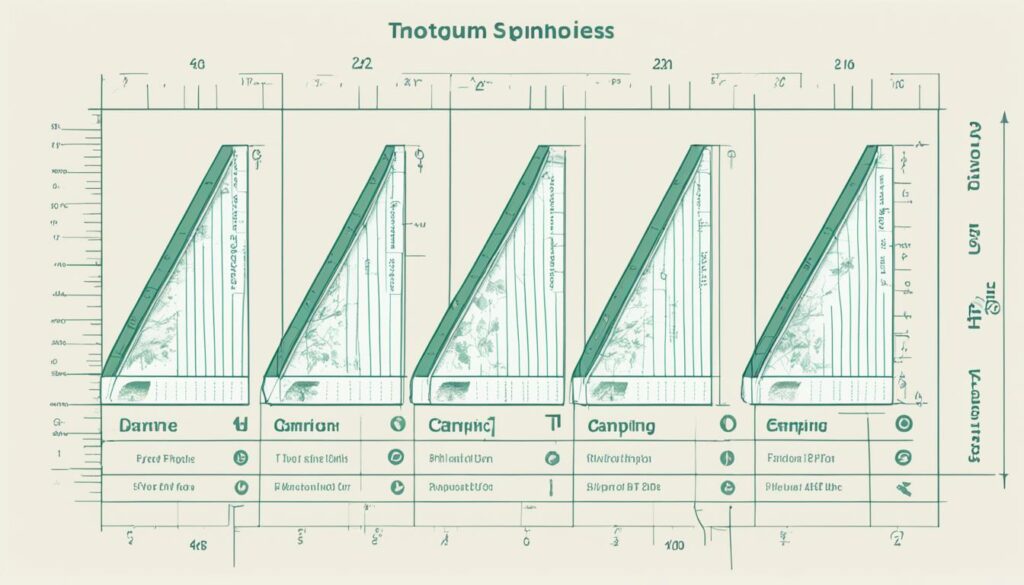Just a tiny bit of wear, like a single square inch, can cut a tent’s life in half. That makes a tent footprint very important. It’s often forgotten, but it’s key to protecting your tent. Different tent models need various sizes and shapes for their tent footprints.
A tent footprint is a waterproof ground cloth. It goes under your tent to shield it from damage. Rocks, sticks, and uneven ground won’t hurt your tent thanks to this. For camping and backpacking, a tent footprint is vital to keep your shelter in top shape.
This guide will go over the tent footprint sizes for common tent models. It will help you pick the right one for your next outdoor trip. Whether you’re experienced or just starting, knowing about tent footprints is crucial for your comfort and peace of mind on your journey.
Key Takeaways
- Tent footprints come in a variety of sizes and shapes to fit different tent models.
- Knowing the right footprint dimensions for your specific tent is crucial to ensure proper coverage and protection.
- Tent footprints provide an extra layer of protection, shielding your tent from wear, tear, and punctures caused by the ground.
- Choosing the right tent footprint can extend the life and performance of your shelter.
- Understanding the importance of a tent footprint and selecting the appropriate size can improve your overall camping experience.
What is a Tent Footprint?
A tent footprint is a waterproof ground cloth. It goes under your tent to protect it. It keeps your tent safe from damage by rocks, sticks, and rough ground.
The primary purpose of a tent footprint is to guard your tent’s bottom. It prevents wear, tear, and holes. Made from durable but light fabrics like polyethylene, cuben fiber, oxford nylon, or polyester, it adds protection. This keeps moisture and dirt away, saving your tent from harm.
Definition and Purpose
The tent footprint definition is simple. It’s a waterproof cloth under your tent. Its purpose is to keep your tent floor safe. This way, rocks, sticks, and rough ground won’t damage it.
Materials Used for Tent Footprints
Tent footprints use fabrics like polyethylene, cuben fiber, oxford nylon, or polyester. These tent footprint materials are known for being strong, waterproof, and light. They give your tent an extra shield, keeping it safe.
Why Use a Tent Footprint?
Using a tent footprint on camping and backpacking trips is smart for a few reasons. It keeps your tent’s floor safe from damage by the ground. This is critical for lightweight backpacking tents with delicate fabrics.
Extends Tent Life and Durability
A tent footprint adds a protective layer under your tent. It can extend the life of your tent. This keeps your shelter in great shape for more trips.
Provides Extra Waterproofing
The tent footprint also makes the floor more waterproof. It stops moisture from coming up. This keeps you and your gear dry, even when it’s rainy.
Minimizes Cleaning and Maintenance
Also, a tent footprint makes your life easier. It cuts down on how much you need to clean your tent. It keeps dirt and mud off the floor. So, you can enjoy more time outdoors.
Tent Footprint Dimensions for Popular Tent Models
When picking a tent footprint, make sure it’s made for your tent model. Most companies make footprints that fit their tents perfectly.
Brand Name 1 Tent Models
Brand Name 1, for instance, makes footprints for their Chinook 1P, Evolution 1P, Mirage 1P, and Revolution 1P tents. These footprints are designed to fit each model just right. By knowing the tent footprint dimensions for Brand Name 1, you protect your tent well.
Brand Name 2 Tent Models
Brand Name 2 also has tent footprint options for their popular backpacking tent lines. Getting the correct tent footprint dimensions for Brand Name 2 helps your tent work better for longer.
Brand Name 3 Tent Models
Brand Name 3 does the same for their backpacking tents. It’s important to match the tent footprint dimensions for Brand Name 3 to your tent. This way, you’ll stay dry and get the most from your tent footprint.
Choosing the Right Footprint Size
It’s best to pick a tent footprint a bit smaller than your tent’s size. This way, the edges of the tent are protected from water pooling. This can stop leaks and moisture issues.
For the best fit, choose a footprint that leaves a 2-inch gap all around. This gap is important to stop water from collecting under the tent.
Footprint Should Be Slightly Smaller Than Tent Floor
A smaller footprint is key for your tent’s health. It keeps water from causing problems and makes your camping experience better.
Consider Terrain and Ground Conditions
Think about where you’ll camp when choosing a footprint. Pick a tougher material like polyethylene for rough ground. For softer ground, a thin nylon taffeta should be fine. Choosing the right one ensures your equipment lasts longer.
Setting Up and Using a Tent Footprint
Setting up a tent footprint right is key to its use. Start by placing it where you’ll pitch your tent. Make sure it’s big enough for your tent and gear. Then, stake the corners at least a foot from its edge to keep wet out.
Proper Positioning and Staking
Think about the ground when you lay out your tent footprint. It should be clear of debris and flat. Staking it on all corners and maybe the sides too helps keep it secure.
Connecting Footprint to Tent
If your tent footprint and tent can snap or tie together, do it. This keeps the footprint steady while you camp. Setting up your footprint well also makes your tent last longer.
DIY Tent Footprint Options
Do you want to save money or create something unique? Making your own tent footprint is a good choice. You can use materials like tarps, polycro. You can also use PU-coated nylon, and Tyvek house wrap.
Materials for DIY Footprints
Tarps are strong and not expensive, but they can be big. Polycro is very light and hard to poke through. PU-coated nylon and Tyvek are in the middle. They are not too heavy, last well, and are affordable.
Instructions for Making Your Own
To make a tent footprint, just cut the material a bit smaller than your tent floor. You can also add strong corners or grommets for stakes. It’s simple to create a footprint that fits your tent and where you camp.
Conclusion
A tent footprint is key for camping. It guards your tent’s floor and boosts its performance. Knowing the right size and material for your tent helps you pick the best one. The tent footprint benefits are many, from warding off damage to making your tent easier to clean.
Buying or making a footprint is smart. It keeps your tent safe, no matter the weather. The importance of a tent footprint is huge for protecting your tent and having fun camping safely.
Picking the right one is important. It must fit your tent well. Think about the ground where you’ll camp, too. Using it right can keep your tent going strong for a long time.
Recommended
- BEST BED TENT TO BLOCK OUT LIGHT FOR SLEEP
- BED TENT FOR TRAVEL: SLEEP COZY ON-THE-GO
- INDOOR BED TENT FOR CAMPING COMFORT & FUN

Meet Noah, the soul behind “Best Inflatable Tent” and a true wanderer at heart. Living the van life, Noah has turned his passion for exploring the great outdoors into a lifestyle, earning his living through organizing group travels that bring people closer to nature. With years of firsthand experience in the wild, Noah’s expertise in selecting and utilizing inflatable tents is unparalleled. Through this blog, he shares his profound knowledge and practical tips to help fellow adventurers find their perfect outdoor shelters. Noah’s commitment to delivering genuine, tested insights has made him a trusted authority in the camping community. Join him on this journey to discover the best inflatable tents that make the great outdoors feel like home.
